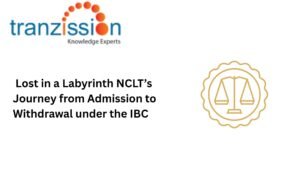
How Legislative Amendments are Shaping IBC
Table of Contents
The Insolvency and Bankruptcy Code, 2016 (IBC) has been amended multiple times to improve the process of insolvency resolution and liquidation. These Amendments are Shaping IBC have been made by the government the insolvency and the Insolvency and Bankruptcy Board of India (IBBI) to make the resolution process more efficient and ensure that creditors receive their money back in a timely manner.
Overview – Why does IBC Require Continuous Amendments?
Since its enactment in 2016, the IBC has undergone multiple Amendments are Shaping IBC to address procedural gaps and emerging challenges of the dynamic legal landscape. Legal amendments to the IBC are necessary to continuously improve the efficiency and effectiveness of the corporate insolvency resolution process (CIRP) to address emerging issues in the market, streamline procedures, protect creditor interests, and adapt to the changing economic conditions. Further, they can be introduced to reduce delays in the insolvency process by setting stricter timelines for various stages of the resolution process. By providing appropriate resolution mechanisms the IBC can address the unique challenges faced by specific industries like real estate or the power sector. Legal reforms can ensure the IBC adapts to the evolving global best practices in insolvency resolution.
Major Amendments are Shaping IBC Future
The time limit for the completion of CIRP:
The Insolvency and Bankruptcy Code (Amendment) Act, 2019 mandated the completion of the CIRP. As per section 12 of the IBC, the CIRP must be completed within 330 days from the commencement of the insolvency process, including any extensions and delays.
Reverse CIRP:
Reverse CIRP is a concept primarily used in the real estate sector where promoters of a distressed project act as lenders. It is at resolving insolvency in real estate companies while protecting homebuyers. Unlike a regular CIRP, the promoters of the real estate project take on the role of primary funders to complete the project instead of a resolution professional managing the process. Developers continue construction instead of asset liquidation and homebuyers receive priority treatment in resolution. Hence, it ensures faster completion of stalled real estate projects and Limits liquidation risks for homebuyers who have already invested.
Read more : Understanding the Interplay of IBC and SEBI Regulations
Pre-packaged Insolvency for MSMEs:
The Insolvency and Bankruptcy Code (Amendment) Act, 2021 introduced the pre-packaged insolvency resolution process (PPIRP), allowing for faster restructuring for small businesses without undergoing full CIRP. PPIRP under Chapter III-A under the IBC offers a more cost-effective, quicker, and higher involvement of creditors for micro, small, and medium enterprises (MSMEs), preserving their business operations and preventing job losses.
Proposed Amendments are Shaping IBC to Enhance Liquidation Framework:
The Insolvency and Bankruptcy Board of India (IBBI) proposes Amendments are Shaping IBC to enhance the liquidation framework, primarily focusing on improving efficiency, transparency, and accountability in the process. They work towards introducing measures like stricter bidder eligibility checks, streamlined auction timelines, mandatory detailed disclosures by liquidators, and better management of unclaimed proceedings in the Corporate Liquidation Account. Further, the IBBI will attempt to establish stronger creditor rights in liquidation voting and accelerated resolution for asset-rich but debt-laden companies.
Challenges in Implementing Amendments are Shaping IBC
Delays in CIRP Despite Legislative Changes:
Despite a 330-day resolution timeline, most cases extend beyond the time limit under section 12. This significantly erodes the value of a distressed company’s assets, leading to lower recoveries for creditors and hindering the overall goal of timely resolution and economic stability. These delays are often caused by factors like court backlogs, litigation, lack of qualified bidders, and disputes between stakeholders at the National Company Law Tribunal (NCLT).
Conflict Between IBC & Other Regulatory Laws:
IBC faces challenges in balancing insolvency laws with Securities Exchange Bank of India regulations for listed companies and RERA compliance for real estate projects, despite the overriding effect of section 238 of the IBC.
Limited Awareness & Execution Challenges:
The limited awareness of the mechanisms under the IBC can be a barrier to the efficient resolution of financial difficulties. For instance, MSMEs and homebuyers may lack legal clarity on Amendments are Shaping IBC, particularly regarding PPIRP, leading to underutilization of the new provisions.
Judicial Interpretations Strengthening IBC Reforms
In the case of Pioneer Urban Land and Infrastructure Ltd. v. Union of India, the Supreme Court upheld the constitutionality of the IBC (Second Amendment) Act, 2018, which significantly classified “allottees”, homebuyers in real estate projects, as “financial creditors” under section 5(8)(f). This allows homebuyers to initiate insolvency proceedings against a real estate company if the project is delayed or not delivered, giving homebuyers more power to seek redress under the IBC if they are financially impacted by a project delay. In its ruling in Manish Kumar v. Union of India, the Supreme Court determined that in cases where the full debt has not been paid back, a financial creditor may file for bankruptcy against a corporation that is in default under Section 7. Hence, the court upheld a minimum threshold for homebuyers to initiate insolvency, preventing misuse of IBC against real estate developers.
Conclusion
The IBC has undergone several reforms to improve the insolvency resolution process in India. For instance, reverse CIRP focuses on real estate, primarily used in situations where real estate projects are stalled, allowing promoters to infuse funds and complete construction to protect homebuyer interests. Through Amendment Act, 2021, the PPIRP was introduced and established a pre-negotiation between the debtor and creditors, aiming to reach a faster resolution, compared to CIRP. In an effort to simplify the liquidation process, the IBBI amended the IBC to reduce paperwork and streamline the administrative steps. It included initiatives to expedite the sale of a company’s assets during liquidation to maximize creditor recovery. Further, this legal amendment utilized digital platforms to enhance transparency and efficiency in the liquidation process.





